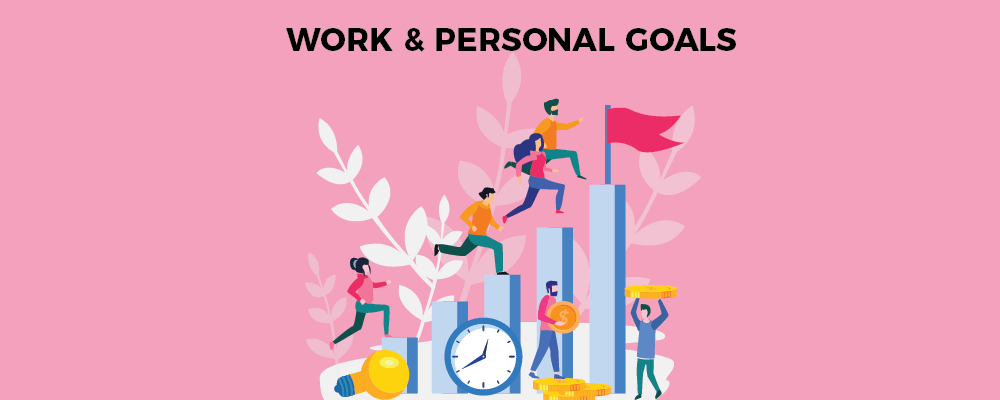Personal goals examples for work
Personal goals examples for work are the goals that employees set for themselves to achieve their desired outcomes in their professional lives. These goals are driven by an individual’s personal motivations, aspirations, and values, and can range from developing new skills to achieving promotion. Personal goals examples for work are important because they help employees take ownership of their career development and growth, and can contribute to their overall job satisfaction and fulfillment. These goals can be set in addition to or in alignment with an organization’s goals, and work goals examples can be used to improve an employee’s performance, productivity, and engagement.
What is work goal and personal goal?
A work goal is a specific objective or outcome that an employee sets for themselves within the context of their job or career. Work goals are typically set to improve job performance, productivity, and professional growth. Examples of work goals may include achieving a certain level of sales, mastering a new skill, completing a project within a certain timeframe, or being promoted to a higher position.
On the other hand, a personal goal is an objective or outcome that individual sets for themselves in their personal life, outside of work. Personal goals can be related to health, fitness, relationships, education, travel, or any other aspect of a person’s life that they wish to improve or achieve. Examples of personal goals may include running a marathon, learning a new language, taking a cooking class, traveling to a new country, or volunteering for a charitable organization.
While work goals and personal goals may be different, they can overlap and influence each other with work goals examples. For instance, achieving a personal goal such as running a marathon may require an employee to improve their fitness level, which can lead to increased productivity and focus in their work. Similarly, achieving a work goal such as mastering a new skill can boost an employee’s confidence and sense of accomplishment, which can spill over into their personal life.
Personal goals examples
Here are some personal goals examples:
- Get in shape and lose weight:
Setting a goal to get fit and lose weight can involve starting an exercise routine, changing your diet, and tracking progress with a fitness app or journal.
- Learn a new skill:
Setting a goal to learn a new skill, such as a language or musical instrument, can involve enrolling in a class, finding a tutor, or using online resources.
- Volunteer:
Setting a goal to volunteer for a charitable organization or cause can involve researching opportunities, finding a local organization, and committing to a regular volunteer schedule.
- Travel:
Setting a goal to travel to a new place, whether it’s within your country or internationally, can involve saving money, planning an itinerary, and researching cultural attractions.
- Read more:
Setting a goal to read more books, whether for personal or professional development, can involve making a reading list, setting aside time each day for reading, and tracking progress with a reading log.
- Improve relationships:
Setting a goal to improve your relationships with friends or family members can involve setting aside time for quality conversations, attending counseling or therapy, or practicing active listening skills.
- Start a hobby:
Setting a goal to start a new hobby, such as painting, gardening, or cooking, can involve purchasing necessary supplies, taking a class, or finding online tutorials.
What are some good personal professional goals?
Here are some examples of good personal and professional goals:
- Improve time management skills: Setting a goal to improve your time management skills can involve creating a daily schedule, prioritizing tasks, and avoiding distractions to increase productivity.
- Build a professional network: Setting a goal to build a professional network can involve attending industry events, joining a professional organization, or networking with colleagues to gain new insights and opportunities.
- Learn a new skill: Setting a goal to learn a new skill, such as coding or project management, can increase your value as an employee and open up new career opportunities.
- Improve communication skills: Setting a goal to improve your communication skills, such as public speaking or writing, can help you to better convey your ideas and connect with colleagues and clients.
- Take on a leadership role: Setting a goal to take on a leadership role, such as managing a team or leading a project, can demonstrate your ability to take initiative and contribute to the success of your organization.
- Develop a personal brand: Setting a goal to develop a personal brand can involve creating a professional website or social media presence, building a portfolio of work, or establishing a reputation as an expert in your field.
- Pursue a promotion: Setting a goal to pursue a promotion can involve identifying the skills and experience required for the position, seeking feedback and mentoring from colleagues, and taking on additional responsibilities to demonstrate your readiness for the role.
Work goals examples
Here are some work goals examples:
- Increase sales revenue:
Setting a goal to increase sales revenue involves developing and implementing sales strategies, identifying new markets or customers, and tracking progress and adjusting tactics as needed.
- Improve customer satisfaction:
Setting a goal to improve customer satisfaction involves developing and implementing customer service strategies, gathering feedback and insights, and addressing concerns and issues promptly.
- Enhance productivity:
Setting a goal to enhance productivity involves finding ways to streamline processes, improve workflow, and reduce inefficiencies to increase output and efficiency.
- Develop new products or services:
Setting a goal to develop new products or services involves conducting market research, identifying gaps in the market, and creating and launching new offerings to meet customer needs.
- Improve employee engagement:
Setting a goal to improve employee engagement involves creating a positive and supportive work environment, providing opportunities for career development and advancement, and recognizing and rewarding employee contributions.
- Enhance brand awareness:
Setting a goal to enhance brand awareness involves developing and implementing marketing strategies, utilizing social media and other channels to reach target audiences, and tracking and analyzing brand metrics.
- Increase profitability:
Setting a goal to increase profitability involves analyzing financial data, identifying areas of cost savings or revenue growth, and implementing strategies to improve profitability over time.
Daily work goals examples
Here are some examples of daily work goals:
- Prioritize tasks:
Setting a goal to prioritize tasks involves identifying the most important tasks for the day and focusing on completing those tasks first.
- Manage time effectively:
Setting a goal to manage time effectively involves utilizing time management tools and techniques, such as the Pomodoro technique, and avoiding distractions and time-wasting activities.
- Communicate effectively:
Setting a goal to communicate effectively involves practicing active listening, asking questions, and providing clear and concise instructions or feedback.
- Collaborate with colleagues:
Setting a goal to collaborate with colleagues involves working together to achieve common goals, sharing information and resources, and providing support and feedback to each other.
- Learn something new:
Setting a goal to learn something new each day involves seeking out opportunities for learning and growth, such as reading industry publications or attending training sessions.
- Improve work processes:
Setting a goal to improve work processes involves identifying areas for improvement, such as streamlining procedures or reducing waste, and implementing changes to improve efficiency and productivity.
- Maintain a positive attitude:
Setting a goal to maintain a positive attitude involves focusing on solutions rather than problems, practicing gratitude, and approaching challenges with a growth mindset.
Personal goals for work evaluation
Here are some personal goals for work evaluation:
- Develop a growth mindset:
Setting a goal to develop a growth mindset involves being open to new challenges and learning opportunities, and viewing failures as opportunities to learn and improve.
- Take ownership of projects:
Setting a goal to take ownership of projects involves taking initiative and responsibility for the success of the project, and seeking feedback and guidance when necessary.
- Improve work-life balance:
Setting a goal to improve work-life balance involves setting boundaries and prioritizing personal time, such as scheduling regular exercise or hobbies, and avoiding working outside of normal work hours.
- Increase productivity:
Setting a goal to increase productivity involves finding ways to work more efficiently, such as utilizing technology or delegating tasks, and setting realistic goals and deadlines.
- Improve teamwork skills:
Setting a goal to improve teamwork skills involves being a supportive and collaborative team member, communicating effectively, and seeking to understand and address the perspectives and needs of others.
- Develop leadership skills:
Setting a goal to develop leadership skills involves taking on leadership roles, such as mentoring or training colleagues, and seeking feedback and guidance to improve communication and decision-making skills.
- Enhance professional development:
Setting a goal to enhance professional development involves seeking out training and development opportunities, such as attending workshops or conferences, and staying up-to-date with industry trends and best practices.
Personal development goals examples
Here are some personal development goals examples:
- Improve communication skills:
Setting a goal to improve communication skills involves learning to express ideas clearly, listening actively, and giving and receiving feedback effectively.
- Develop leadership skills:
Setting a goal to develop leadership skills involves learning to motivate and inspire others, delegate tasks, and make decisions that benefit the team and organization.
- Enhance time management skills:
Setting a goal to enhance time management skills involves learning to prioritize tasks, avoid distractions, and use time management tools effectively.
- Improve problem-solving skills:
Setting a goal to improve problem-solving skills involves learning to identify and analyze problems, generate and evaluate potential solutions, and implement effective solutions.
- Build emotional intelligence:
Setting a goal to build emotional intelligence involves learning to recognize and regulate emotions, develop empathy, and build strong relationships with others.
- Learn a new skill:
Setting a goal to learn a new skill involves identifying a skill or subject of interest, setting a learning goal, and finding opportunities for learning and practice.
- Build resilience:
Setting a goal to build resilience involves developing coping skills, practicing self-care, and maintaining a positive outlook during challenging times.
Personal development plan for work examples
Here are some examples of a personal development plan for work:
- Identify strengths and weaknesses:
Take an inventory of your strengths and weaknesses in terms of skills, knowledge, and experience. This can help you identify areas for improvement and create a plan to develop your skills and knowledge.
- Set achievable goals:
Develop a set of achievable goals that are specific, measurable, attainable, relevant, and time-bound (SMART). This will help you focus on areas for improvement and track your progress over time.
- Seek out training and development opportunities:
Identify training and development opportunities that will help you improve your skills and knowledge in areas that need improvement. This could include attending conferences, taking online courses, or seeking out a mentor.
- Seek feedback and evaluate progress:
Seek feedback from colleagues, supervisors, and other professionals to evaluate your progress and identify areas for improvement. Use this feedback to adjust your personal development plan as needed.
- Build relationships:
Build strong relationships with colleagues, mentors, and other professionals to learn from their experiences and gain new perspectives on your work.
- Stay current in your field:
Stay up-to-date on developments in your field by reading industry publications, attending conferences, and participating in professional organizations.
- Take on new challenges:
Look for opportunities to take on new challenges and expand your skills and knowledge. This could include taking on new responsibilities, volunteering for projects, or seeking out new experiences.
Personal and professional goals examples
Here are some personal and professional goals examples:
Personal goals:
- Learn a new language
- Read a book every month
- Volunteer at a local charity or organization
- Spend more time with family and friends
- Travel to a new destination
Professional goals:
- Attend a professional development workshop or conference
- Earn a new certification or degree
- Improve time management skills
- Increase productivity by implementing new tools or systems
- Develop stronger leadership skills
- Expand professional network by attending industry events or joining professional organizations
- Improve public speaking skills through practice and training
- Enhance technical skills through additional training or education
Smart goals for career development examples
Here are some examples of SMART goals for career development:
- Obtain a certification in a specific area of expertise within the next six months by completing a relevant course and passing the exam with a score of at least 90%.
- Attend at least two professional development conferences within the next year to network with industry experts and learn about emerging trends and best practices in the field.
- Increase productivity by 25% within the next six months by implementing time management techniques, such as prioritizing tasks, using a task list, and setting specific deadlines.
- Complete a leadership training program within the next year to improve communication skills, conflict resolution skills, and ability to manage and motivate team members.
- Develop a strong online professional brand within the next three months by creating a professional website and social media accounts and regularly sharing content related to the industry.
- Increase sales by 15% within the next year by developing a targeted marketing plan, increasing customer engagement, and expanding the customer base.
- Increase proficiency in a new programming language within the next six months by attending training courses, participating in coding challenges, and completing online tutorials.
Personal development plan for work examples
Here are some examples of a personal development plan for work:
- Improve communication skills:
Take a course or workshop on effective communication, practice active listening, and ask for feedback from colleagues and supervisors.
- Develop leadership skills:
Attend a leadership training program, seek mentorship from a senior executive, and take on more leadership responsibilities at work.
- Enhance technical skills:
Attend training sessions, participate in online tutorials, and take on projects that require the use of new technologies or software.
- Improve time management:
Set specific goals, prioritize tasks, create a schedule or task list, and track progress regularly.
- Expand professional network:
Join professional organizations, attend industry events and conferences, and actively seek out opportunities to network with colleagues and industry experts.
- Develop a strong online presence:
Create a professional website, develop a personal brand, and participate in online forums and discussion groups related to the industry.
- Enhance critical thinking skills:
Engage in problem-solving exercises, participate in brainstorming sessions, and seek out diverse perspectives and feedback from colleagues.
Pros and cons of personal goals examples for work
Here are some potential pros and cons of setting personal goals examples for work:
Pros:
- Clarity:
Personal goals can help clarify what you want to achieve in your career and how to achieve it.
- Motivation:
Setting personal goals can provide motivation to work harder and achieve better results.
- Self-awareness:
Personal goals can help you identify your strengths and areas for improvement, allowing you to take action to develop your skills.
- Progress tracking:
By setting personal goals, you can track your progress and see how far you have come.
Cons:
- Time-consuming:
Setting personal goals requires time and effort, which may take away from other important work tasks.
- Unrealistic expectations:
Setting overly ambitious personal goals may lead to disappointment and frustration if they are not achieved.
- Lack of flexibility:
Setting rigid personal goals may make it difficult to adapt to changing circumstances or new opportunities.
- Lack of support:
If personal goals are not aligned with organizational goals, there may be a lack of support from management or colleagues.
Faqs
Here are some frequently asked questions (FAQs) about personal goals examples for work:
Q.1 Why are personal goals important in the workplace?
Personal goals are important in the workplace because they provide focus, motivation, and direction. They help individuals identify their strengths and areas for development, and set specific objectives to achieve.
Q.2 How do I identify personal goals for work?
To identify personal goals for work, start by reflecting on your career aspirations, values, strengths, and weaknesses. Consider what you want to achieve in your career and what areas you need to develop to get there.
Q.3 What are some common personal development goals for work?
Common personal development goals for work include improving communication skills, enhancing leadership abilities, expanding technical knowledge, developing time-management skills, and building a professional network.
Q.4 How do I create a personal development plan for work?
To create a personal development plan for work, start by identifying your goals and objectives. Then, develop an action plan with specific steps to achieve those goals. Consider what resources you need, such as training or mentorship, and establish a timeline for completing each step.
Q.5 How do I measure progress towards personal goals for work?
To measure progress towards personal goals for work, set specific and measurable targets, and regularly track your progress against those targets. Seek feedback from colleagues and supervisors, and adjust your plan as needed to stay on track.
Final thoughts
In summary, personal goals are essential for professional growth and development in the workplace. They help individuals focus their efforts, identify areas for improvement, and achieve their career aspirations. By setting personal goals, creating a plan of action, and regularly monitoring progress, individuals can take control of their professional development and achieve success in their careers. It is important to remember that personal goals should be SMART (specific, measurable, achievable, relevant, and time-bound) and aligned with the individual’s values and career aspirations.




Post Comment